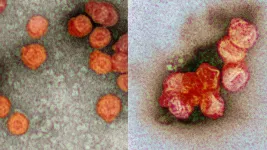(Press-News.org) BATON ROUGE, LOUISIANA - In patients with type 2 diabetes, big swings in blood sugar levels between doctors' visits are associated with an increased risk of heart disease.
The study, published in the journal Diabetes, Obesity & Metabolism, looked at more than 29,000 patients with type 2 diabetes over a two-year period. Patients who already had heart disease were excluded.
The American Diabetes Association recommends adults with diabetes maintain an A1c, the average blood sugar level over the past two to three months, of less than 7 percent to reduce complications from diabetes, such as heart disease. However, studies - including this one -- have shown that wide swings in blood sugar levels may be a better predictor of diabetic complications than the A1c reading at any single doctor's office visit.
"The underlying mechanism for the relationship between wide variations in blood sugar levels between doctor's appointments and high risk of heart disease in patients with type 2 diabetes is unclear," said Gang Hu, MD, PhD, Associate Professor and Director, Chronic Disease Epidemiology Lab at Pennington Biomedical Research Center. "It's possible that episodes of severely low blood sugar may be the connection."
Research has shown that wide variations in blood sugar levels are associated with poor health outcomes and even death. A 2017 Johns Hopkins study found that one-third of people with diabetes hospitalized for a severe low blood sugar episode died within three years of the incident.
"We recommend that patients and their doctors implement therapies that can reduce wide swings in blood sugar levels and the associated episodes of severe low blood sugar," Dr. Hu said. " END
Extreme blood sugar swings in people with type 2 diabetes may increase heart disease risk
2021-02-03
ELSE PRESS RELEASES FROM THIS DATE:
Research looks at the link between procedures and everyday practice in community pharmacy
2021-02-03
A study published in the journal Applied Ergonomics compared the standardised processes set out for community pharmacists to follow when dispending medication to what happens in reality. A gap was revealed and researchers also looked at the reasons for this.
The research, "Mind the gap: Examining work-as-imagined and work-as-done when dispensing medication in the community pharmacy setting"*, was conducted by the National Institute for Health Research Greater Manchester Patient Safety Translational Research Centre (NIHR GM PSTRC). The Centre is a partnership between The University of Manchester and Salford Royal NHS Foundation Trust.
The research involved observing pharmacists and pharmacy staff as they conducted the task of dispensing, ...
Sneakerheads, not hypebeasts: Defining a sneaker-driven sub-culture
2021-02-03
Sneakers can be about style, history and even community. A new study reveals that for "Sneakerheads," sneakers are an important facet of their identities, particularly for African-American men who grew up in the 1970s and '80s coveting sneakers popularized by hip-hop stars and basketball legends.
In the journal Fashion and Textiles, researchers report new insights into the motivations, brand preferences and identity considerations of Sneakerheads. The findings were drawn from interviews with 12 men in the mid-Atlantic region of the United States, many whom are African-American, and ...
Computerized adaptive screener may help identify youth at risk for suicide
2021-02-03
Researchers have developed a computerized adaptive screener to identify youth at risk for attempting suicide. The screener, called the computerized adaptive screen for suicidal youth (CASSY), consists of 11 questions on average and correctly identified 82.4% of youth who went on to attempt suicide in the three months following screening. The results suggest this screener could serve as an easy-to-use way for providers to detect youth suicide risk in emergency department settings. The findings, funded by the National Institute of Mental Health (NIMH), ...
How modern robots are developed
2021-02-03
Today, neuroscience and robotics are developing hand in hand. Mikhail Lebedev, Academic Supervisor at HSE University's Centre for Bioelectric Interfaces, spoke about how studying the brain inspires the development of robots.
Robots are interesting to neuroscience and neuroscience is interesting to robots - this is what the article 'Neuroengineering challenges of fusing robotics and neuroscience' was about in the journal Science Robotics. Such collaborative development contributes to progress in both fields, bringing us closer to developing more advanced android robots and a deeper understanding ...
Standard water treatment eliminates enveloped viruses -- like the coronavirus
2021-02-03
Among the many avenues that viruses can use to infect humans, drinking water may pose only a tiny risk for spreading certain viruses like the novel coronavirus. However, in cases where there is unauthorized wastewater disposal or other events of inadvertent mixing of wastewater with water sources, the possibility of transmission through drinking water remains unknown.
Using a surrogate of the coronavirus that only infects bacteria, researchers at Texas A&M University have now presented strong evidence that existing water purification plants can easily reduce vast quantities of the virus thereby protecting our household water from such contagions. In particular, the researchers showed that the water purification step called coagulation could alone get rid of 99.999% of ...
The business of bees
2021-02-03
The economic value of insect pollinators was $34 billion in the U.S. in 2012, much higher than previously thought, according to researchers at the University of Pittsburgh and Penn State University. The team also found that areas that are economically most reliant on insect pollinators are the same areas where pollinator habitat and forage quality are poor.
"Pollinators like bees play an extremely important role in agriculture," explained senior author Vikas Khanna, Wellington C. Carl Faculty Fellow and associate professor of civil and environmental engineering at Pitt's Swanson School of Engineering. "The insects that pollinate farmers' crops underpin our ecosystem biodiversity and function, ...
Preventive anti-clotting therapy does not boost survival of critically ill COVID patients
2021-02-03
BOSTON - Although abnormal blood clotting has been identified as one of the primary causes of death from COVID-19, early treatment in an intensive care unit (ICU) with therapeutic anticoagulation (anti-clotting) for adults who are critically ill with COVID-19 does not appear to improve chances of survival, and could do more harm than good by increasing the risk for major bleeding, a multicenter research group cautions.
"In patients critically ill with COVID-19, therapeutic dose anticoagulation started early in the ICU stay was not associated with improved survival,"says Hanny Al-Samkari, MD, an investigator in the Division of Hematology/Oncology at Massachusetts General Hospital (MGH) and lead author ...
Most vulnerable often overlooked in clinical trials of new treatments for COVID-19
2021-02-03
Studies examining the effectiveness of treatments for COVID-19 often do not include the very populations hardest hit by the disease, according to a new review by University of Chicago Medicine researchers.
The findings, based on an analysis of all US COVID-19 treatment trials registered on ClinicalTrials.gov, were published Jan. 27 in the Journal of General Internal Medicine.
"This study highlights the blind spot in how clinical trials are done in the United States," said senior author Neda Laiteerapong, MD, MS, a general internist and associate director of the Center for Chronic Disease Research and Policy at the University of Chicago. "Researchers, hospitals and pharmaceutical ...
Scientists discover plants' roadblock to specialty oil production
2021-02-03
UPTON, NY - Hundreds of naturally occurring specialty fatty acids (building blocks of oils) have potential for use as raw materials for making lubricants, plastics, pharmaceuticals, and more--if they could be produced at large scale by crop plants. But attempts to put genes for making these specialty building blocks into crops have had the opposite effect: Seeds from plants with genes added to make specialty fatty acids accumulated dramatically less oil. No one knew why.
Now two teams of biochemists working on separate aspects of oil synthesis at the U.S. Department of Energy's Brookhaven National Laboratory have converged to discover the mechanism behind the oil-production slowdown. As described in the journal Plant Physiology, they crossbred model plants and conducted detailed ...
Moffitt researchers discover mechanism that regulates anti-tumor activity of immune cells
2021-02-03
TAMPA, Fla. -- The prognosis of ovarian cancer is poor, with an estimated five-year survival of only 40% for advanced disease, the stage at which most ovarian carcinomas are diagnosed. These poor outcomes are partly due to the lack of effective therapies for advanced disease and recurrence. Immunotherapies hold promise for many types of cancer; however, studies have shown that patients with ovarian cancer do not have strong responses to existing drugs. In a new article published in Nature, Moffitt Cancer Center researchers demonstrate why some ...


